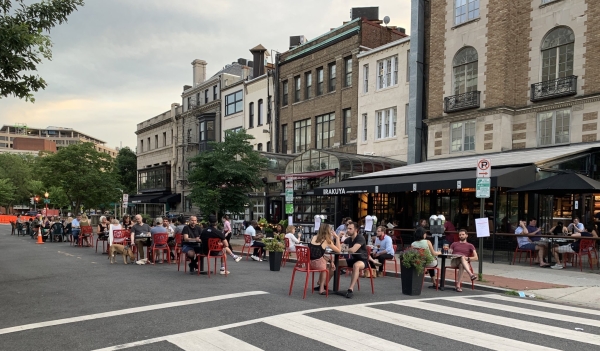Quick-Build Projects: How Speedy Redesigns Are Increasing Street Safety and Effectiveness

By Cerasela Cristei, WTS-DC
Over the past year, many of us have enjoyed outdoor dining in spaces that would otherwise be car parks or part of the road. These spaces are one example of the temporary projects or “quick-builds” that popped up to help cities around the world adapt to COVID. These quickly installed projects met our changing needs for space within the public realm, enhanced active travel and recreation opportunities (i.e., walking or cycling), provided public gathering space and, of course, expanded outdoor dining to help businesses better serve their customers with indoor dining restrictions. It also made us more comfortable with experimenting and potentially paved the way for cities better to meet the challenges ahead. While these temporary quick-build projects were driven by the necessity for short-term fixes, how can cities in the DMV draw deeper lessons from these experiences to make our streets safer and more accessible to all stakeholders?
On April 22, Earth Day, WTS-DC’s Professional Development Committee teamed up with Nathan George of APA Virginia to host a quick-build virtual event. Panelists included Alex Carroll, Urban Planner at City of Alexandria Department of Transportation and Environmental Services; Pat Shepherd, Capital Projects Manager and Bikeways Coordinator with Montgomery County Department of Transportation; and Megan Kanagy, Bus Priority Program Manager with the District Department of Transportation.
For quick-build projects, it is still very important to gauge the public’s opinion about the proposed improvements and assessing the existing conditions and developing the proposed design with the minimum impact on the community.
In the City of Alexandria that necessity is the mother of invention and when a need is identified the city’s planners look at how such needs were addressed by other similar size communities, and then tailor the measures to the city’s specific conditions. In her current role, Carroll assesses what short-term improvements can be implemented for immediate benefits when there is a longer term solution available, but it is too costly, or it is going to take too long. Among those measures are temporary trails/sidewalk, pavement markings, temporary curb extensions, and flexible barriers. During the pandemic, Alexandria implemented an outdoor dining program and an open street plan on the 100th block of King Street, which proved to be very popular.
The District of Columbia adopts a similar approach by assessing the needs against the existing conditions and implementing the most practical, immediate, and cost-effective solution. This is done within the framework of the long-range plan. However, Kanagy related how at DDOT there is not always a clear line between quick-build and some of the more traditional delivery projects, as the department is trying to do everything faster while addressing the immediate safety and mobility needs of the public.
As the bikeways coordinator for Montgomery County, Shepherd spoke to the unique dense urban makeup of the county, surrounded by suburban and rural areas. Due to this varied density, quick-build projects within the county can also vary widely.
Shifting to the changes brought by the pandemic environment, all three panelists emphasized that they saw and nurtured an increased attention to the public health. They saw a change in mindset where health and well-being are the number one priority. Spaces previously dedicated to vehicular traffic were barricaded and open to pedestrian traffic, or to outdoor dining. By implementing such measures, design professionals gave people the chance to see how such spaces operate and build an appetite for trying similar measures in the future.
At the end of the event the panelist encouraged women to enter the transportation field as professionals. The profession is very rewarding, and the most important part is to be a very good communicator. The consensus in the “room” was that women are good communicators. Having diverse groups working together will result in better solutions to problems small and large. Regardless of gender and age, it is important to trust that you might bring a unique experience to the table even if you are in a room that may not look a lot like you.
This virtual event was organized in honor of the Professional Development Committee’s annual bike tour event. The event doubled as a scholarship fundraiser and as an educational event for multimodal facilities planners and designers. In addition, the event helped novice bikers become familiar and comfortable using on-street bike facilities. A follow-up in-person bike tour of quick-build projects may be organized later in the year or as soon as the state of the pandemic allows.